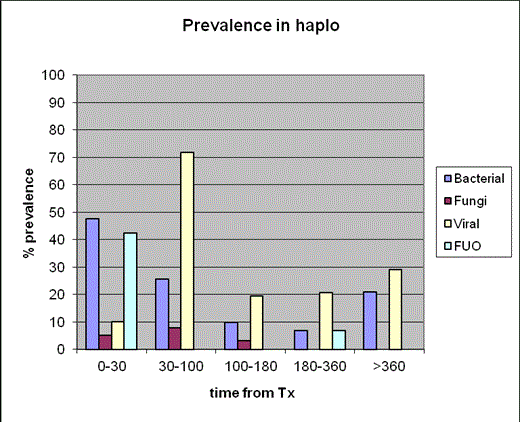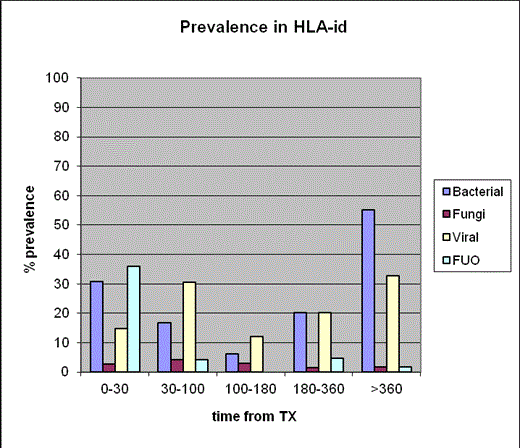a major limitation of hematopoietic stem cell transplantation (HSCT) from haploidentical donor is the impaired immune reconstitution due to extensive immunosuppression necessary to overcome HLA disparity. Recently, a platform for T-cell repleted HSCT from haploidentical donor (haplo-HSCT) using post-transplant cyclophosphamide (CTX) has been reported, with low TRM and high reproducibility. However, little has been reported so far about immune reconstitution and, in particular, incidence of infections after this type of transplantation.
to describe infectious complications after T-cell replete haplo-HSCT after NMA conditioning performed at our center and to compare them with HLA-identical transplantations performed at the same center.
data on patients with hematological malignancies who underwent haplo-HSCT were collected and compared with RIC/NMA-HSCT from HLA-identical donors. Transplants included were those performed up to 31st December 2012. Infections were classified as FUO, bacterial, micotic or viral and prevalence over five post-transplant intervals was estimated: days 0-30, 31-100, 101-180, 181-365, >365. Prevalence for each time period was defined as the number of infectious events/patients at risk.
we identified a total of 72 and 40 patients transplanted from HLA-identical or haploidentical donor respectively. Median follow-up was longer in HLA-identical vs. haploidentical (34 vs. 15 months, p<0.0001). Among 38 out of 40 haplo-HSCT patients, a total of 96 infectious events occurred, with a median of 3 events/patient (range: 0-6). Etiologies were as follows: 39 bacterial, 6 fungal and 51 viral. Bacterial infections occurred mostly between day 0 and +30, whereas viral infections/reactivations between +30 and +100 (see Figure 1a ). In the HLA-identical cohort, 166 events occurred among 64 out of 72 patients, with a median of 2 events/patient (range: 0-8); etiologies were: 84 bacterial, 9 fungal and 73 viral. FUO events were 19 and 34 among haplo- and HLA-identical transplants respectively. Prevalence of infections was lower in HLA-identical compared with haplo-HSCT group, but subdistribution of etiologies was similar overtime (see Figure 1b ), with bacterial and FUO mostly before day+30 and viral events mostly between +30 and +100. Importantly, no fungal infections occurred beyond day +180 in haplo group, probably due to the low incidence of chronic GVH. Conversely, higher prevalence of bacterial events observed in HLA-identical group may be due to chronic GVH. Deaths due infection were 25% in haplo group (10/40, occuring between +13 and +152) and 11% (8/75) among HLA-identical transplants.
RIC haplo-SCT with post-transplant CTX shows a slightly higher rate of infectious complications compared with HLA-identical ones. Subdistribution of etiologies is similar, with the highest prevalence of viral infections between +30 and +100 and no fungal events after +180. Thus, in haplo-SCT, immunological recovery appears to be satisfactory after +180. Future comparisons with other alternative stem cell sources (i.e. cord blood) are warranted.
No relevant conflicts of interest to declare.



This feature is available to Subscribers Only
Sign In or Create an Account Close Modal